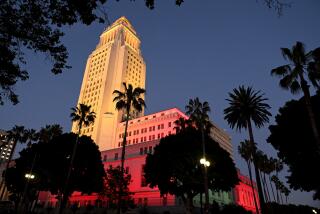Commentary : Panel Shows Its Power in Library Fray
Under the soft chorus of harmonious approval that greeted the revised Central Library design last week is a hard and significant fact: The Cultural Affairs Commission, once perceived as a compliant rubber stamp, has become a major player in the struggle to improve the architecture of public projects in Los Angeles.
The acceptance of the revised design by four city commissions marks not only the resolution of an often acrimonious 14-month design dispute, but by many accounts a watershed in the way we go about getting good public buildings in Los Angeles.
The dispute over the $152.4-million expansion of the landmark downtown library came to an end Thursday when the Cultural Affairs Commission, Cultural Heritage Commission, Community Redevelopment Agency and Library Commission, in an unusual joint meeting, all approved the library’s east-wing expansion scheduled to open in 1992.
Arguments over the design had pitted the Cultural Affairs Commission, which has final design approval for all structures built on or over city property, against other city agencies and several prominent political power brokers. The commission had tabled Hardy Holzman Pfeiffer Associates original design in February, 1987.
Though Mayor Tom Bradley, the City Council, Library Commission and Community Redevelopment Agency expressed support for the original plan, the Cultural Affairs Commission stood its ground, citing eight “concerns” and insisting that architect Norman Pfeiffer revise the proposal. Of particular concern was the proposed east wing, whose cathedral windows and peaked roof challenged the scale of Bertram Goodhue’s much-loved 1924 landmark design, in the commission’s view.
Modifications intended to satisfy the commission include elimination of the prominent peaked atrium roof over the library’s east wing, a more compact and lower east wing as a whole, and the toning down of materials to make them more compatible with Goodhue’s stucco idiom.
“The earlier design challenged Goodhue’s architecture,” Pfeiffer concurred after Thursday’s session. “This time around I decided to take my clues from Goodhue and continue his unique Modernist Beaux-Arts style. This is a less radical and more traditional approach, but it creates many fewer problems for me, and for everyone else.”
Said architect Kurt Meyer, president of the Urban Design Advisory Coalition, a group of prominent architects advising the commission: “What we have in the present proposal is not a great library building, but a . . . compromise . . . a lot better than Pfeiffer’s first offering.
“The best result from this controversy may well be the strengthening of the hand of the Cultural Affairs Commission in its role as a raiser of architectural standards in the public sector,” he continued. “Because the commission stood its ground, despite a barrage of often ugly flak, all of us who care about the quality of our urban environment can share a much more hopeful future.”
Cultural Affairs Commission president Merry Norris, noting that she was exhausted by the often unpleasant uproar, said: “At this point, I don’t know whether to laugh or cry.”
Decades of Controversy
In fact, controversy over attempts to renovate and expand the Central Library has been ongoing for more than two decades.
In 1966 the Library Committee decided to demolish Goodhue’s aging and no longer very functional masterpiece and replace it with a commercial tower. Many citizens, as well as the local chapter of the American Institute of Architects, fought the demolition decision.
The fate of the rescued library hung in limbo for most of the ‘70s. The city was at a loss to fund the renovation and, at the same time, many argued that it was senseless to fund expansion of the downtown building while the city’s local library system was starved for money.
In 1979 a proposal by Charles Luckman Associates was rejected. It showed, according to one critic, “every promise of irreparably disfiguring perhaps the most distinguished of our civic buildings.”
Finally, in 1981, the city’s Recreation, Library and Cultural Affairs Committee authorized the design of an expanded and renovated building that would “fully respect the present structure’s integrity.”
In August, 1983, Hardy Holzman Pfeiffer Associates was selected by the Library Commission and the Community Redevelopment Agency to prepare concept drawings.
In July, 1984, Pfeiffer submitted a “schematic” block design for the library that featured a three-tiered, stepped-down east-wing expansion.
Funding Plan
Funding for the renovation--then estimated at $130 million--was to be provided by an ingenious scheme dreamed up by Ed Helfeld, then administrator of the Community Redevelopment Agency, and developer Robert Maguire. At the heart of the complex scheme was a deal in which the CRA sold off a transferable block of density or “air” rights on the library site to Maguire so that he could increase the size of his 72-story Library Square development across 5th Street.
Hardy Holzman Pfeiffer Associates was hired to do the basic block design that, once approved, would form the basis for a competition among local architects for the fully evolved building.
However, Helfeld quietly engaged Pfeiffer to carry out the full commission. Despite the snub to local designers, the firm--nationally respected for its skillful renovations of historic buildings across the United States--seemed an excellent choice.
But Pfeiffer ran into a wall when, in February, 1987, he displayed his elaborate models and sketches to the Cultural Affairs Commission for the first time.
Pfeiffer had not consulted the commission while developing the library design. At the same time, the Board of Library Commissioners had allowed the bulk of the building to swell.
Cost on Rise
The original schematic block design had been radically changed. In place of the discreet, step-roofed east wing was a swollen expansion topped by a glazed atrium roof that challenged the central focus of Goodhue’s pyramid-topped tower.
Also escalating was the cost. After Helfeld’s departure in 1985, the CRA had failed to monitor the budgetary impact of the librarians’ increased demands for space and equipment.
The architects found themselves in a difficult position.
“With a program this extensive, our options are limited,” Pfeiffer told the Cultural Affairs Commission later in 1987. “Basically, we can only meet 60% of the program the library desires if we scale the design down to the levels the commission seems to want.”
Several groups concerned with design and preservation supported the Cultural Affairs Commission’s objections, including the Los Angeles Conservancy, the AIA Urban Design Committee and the Urban Design Advisory Coalition. The Conservancy suggested that “reducing the mass of the atrium and eliminating the use of inappropriate materials could result in budget savings.”
More to Read
The biggest entertainment stories
Get our big stories about Hollywood, film, television, music, arts, culture and more right in your inbox as soon as they publish.
You may occasionally receive promotional content from the Los Angeles Times.










